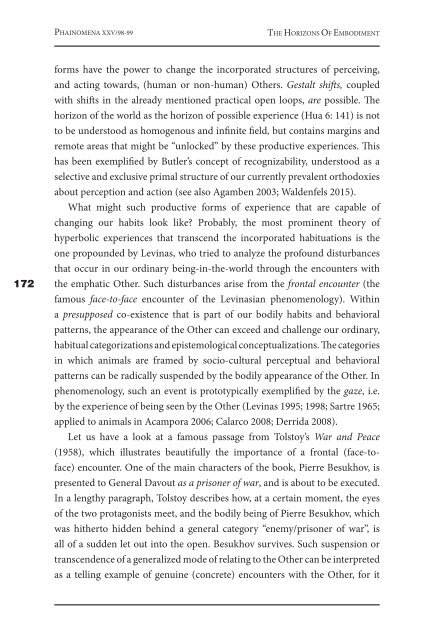phainomena
PHAINOMENA-98-99_e-verzija
PHAINOMENA-98-99_e-verzija
You also want an ePaper? Increase the reach of your titles
YUMPU automatically turns print PDFs into web optimized ePapers that Google loves.
PHAINOMENA XXV/98-99<br />
THE HORIZONS OF EMBODIMENT<br />
172<br />
forms have the power to change the incorporated structures of perceiving,<br />
and acting towards, (human or non-human) Others. Gestalt shifts, coupled<br />
with shifts in the already mentioned practical open loops, are possible. The<br />
horizon of the world as the horizon of possible experience (Hua 6: 141) is not<br />
to be understood as homogenous and infinite field, but contains margins and<br />
remote areas that might be “unlocked” by these productive experiences. This<br />
has been exemplified by Butler’s concept of recognizability, understood as a<br />
selective and exclusive primal structure of our currently prevalent orthodoxies<br />
about perception and action (see also Agamben 2003; Waldenfels 2015).<br />
What might such productive forms of experience that are capable of<br />
changing our habits look like? Probably, the most prominent theory of<br />
hyperbolic experiences that transcend the incorporated habituations is the<br />
one propounded by Levinas, who tried to analyze the profound disturbances<br />
that occur in our ordinary being-in-the-world through the encounters with<br />
the emphatic Other. Such disturbances arise from the frontal encounter (the<br />
famous face-to-face encounter of the Levinasian phenomenology). Within<br />
a presupposed co-existence that is part of our bodily habits and behavioral<br />
patterns, the appearance of the Other can exceed and challenge our ordinary,<br />
habitual categorizations and epistemological conceptualizations. The categories<br />
in which animals are framed by socio-cultural perceptual and behavioral<br />
patterns can be radically suspended by the bodily appearance of the Other. In<br />
phenomenology, such an event is prototypically exemplified by the gaze, i.e.<br />
by the experience of being seen by the Other (Levinas 1995; 1998; Sartre 1965;<br />
applied to animals in Acampora 2006; Calarco 2008; Derrida 2008).<br />
Let us have a look at a famous passage from Tolstoy’s War and Peace<br />
(1958), which illustrates beautifully the importance of a frontal (face-toface)<br />
encounter. One of the main characters of the book, Pierre Besukhov, is<br />
presented to General Davout as a prisoner of war, and is about to be executed.<br />
In a lengthy paragraph, Tolstoy describes how, at a certain moment, the eyes<br />
of the two protagonists meet, and the bodily being of Pierre Besukhov, which<br />
was hitherto hidden behind a general category “enemy/prisoner of war”, is<br />
all of a sudden let out into the open. Besukhov survives. Such suspension or<br />
transcendence of a generalized mode of relating to the Other can be interpreted<br />
as a telling example of genuine (concrete) encounters with the Other, for it


